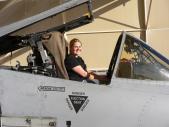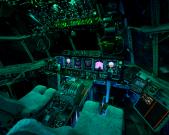A majority of GTRI's military contracts reflect our historical preeminence in radar and electronics. Several noteworthy projects improve the defensive capability of aircraft through different technologies, underscoring the breadth of our capabilities in this area.
Integrated Defensive Avionics Software (IDAS)
Developed by GTRI engineers to complement radar warning, missile warning, and countermeasures systems, IDAS supports rapid threat display and response. It presents accurate and usable information to the aircrew.
IDAS includes a sophisticated threat data correlator that combines information from onboard sensors and data links. It provides real-time threat response management functions required to counter radio frequency and infrared threats. It also includes automated chaff and flare countermeasures.
In addition, IDAS incorporates the Virtual Electronic Combat Training System function in its operational flight program. System capabilities include in-flight aircrew tactics training using simulated threats.
IDAS can be configured for specific missions and individual threat responses. This flexibility makes the system applicable in a range of aircraft, from fixed-wing fighters to rotary-wing craft. Most recently, IDAS was revised under the C-130 Avionics Modernization Program to add capability and update to open-systems standards.
Infrared Countermeasure Solution
When U.S. Military A-10 pilots needed protection from shoulder-fired missiles, GTRI developed an Infrared Countermeasure Solution in under 200 days. GTRI's solution is now in production for all A-10 aircraft and is saving lives today.
Digital Crystal Video Receiver
GTRI researchers invented and patented a digital crystal video receiver, a vital part of the radar warning receiver system that alerts an aircraft crew to enemy ground radar activity. By converting U.S. radar warning receivers from analog to digital circuits, the digital crystal video receiver will provide more stable in-air detection of enemy ground radar at less cost.
The device represents a substantial improvement in reliability, cost, and accuracy over the analog chips they are designed to replace. The key issue is the logarithmic transfer function, which coordinates the input and output of a radar warning receiver's signal-processing system.
In radar warning receivers, the continuous-scale analog chip has been difficult to calibrate and maintain. By contrast, the digital crystal video receiver needs no calibration, performs well under temperature extremes, and is more robust; thus, the circuit is more stable. The digital version is also far less expensive to manufacture and reduces the overall production cost of a radar warning receiver by a factor between five and 10.
The receiver demodulates received radar signals into video waveforms. The waveforms undergo digital signal processing, producing a digital equivalent with a logarithmic function to make processing easier.
Updating Aircraft
Among GTRI's most successful early such projects was an upgrade of the U.S. Air Force's H-53 helicopter. Originally designed as a general-purpose cargo transport, the Air Force wanted a modified craft for special operations forces. GTRI engineers instituted numerous structural improvements that significantly increased payload capacity, along with improved main rotor blades, a more reliable main rotor head, and upgraded engines.
Substantial changes in the mission equipment package were made as well. The changes allowed for safer, more effective navigation at low altitudes in total darkness and adverse weather over all types of topography, including mountainous terrain.
As a cost-saving alternative to building new systems from scratch, the idea of updating aircraft found a receptive audience at the Pentagon and Capitol Hill.




